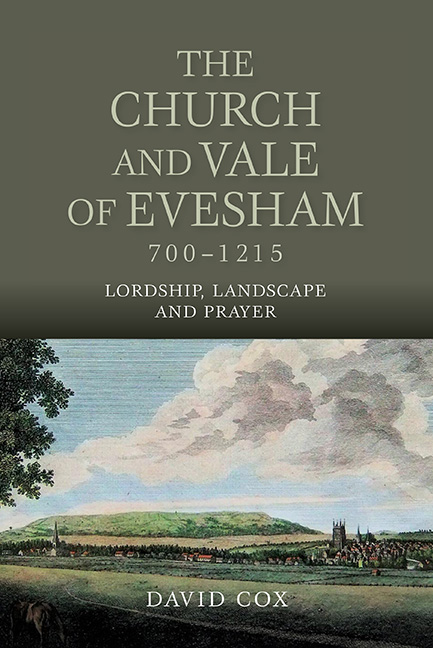Book contents
- Frontmatter
- Dedication
- Contents
- List of Illustrations
- Preface
- Timeline
- List of Abbreviations
- Part I From Minster to Abbey (701–1078)
- Part II Abbot Walter (1078–1104)
- Part III Twelfth-Century Themes (1104–1215)
- Afterword
- Appendix: The Abbots of Evesham to 1215
- Select Bibliography
- Index
- Miscellaneous Endmatter
- Frontmatter
- Dedication
- Contents
- List of Illustrations
- Preface
- Timeline
- List of Abbreviations
- Part I From Minster to Abbey (701–1078)
- Part II Abbot Walter (1078–1104)
- Part III Twelfth-Century Themes (1104–1215)
- Afterword
- Appendix: The Abbots of Evesham to 1215
- Select Bibliography
- Index
- Miscellaneous Endmatter
Summary
The minster site
NO remains of Ecgwine's church have been identified but one begins with the assumption that it was built on the same spot as the later abbey church of Evesham, on the higher ground that overlooked the flood plain at the hamm. To some extent the character of the site can be reconstructed as it was immediately before building began, and that makes possible some suggestions as to why that particular position was chosen for the new minster. Ecgwine was not the first to find it an attractive place. The high ground provided a fertile plateau that had supported Bronze Age and Iron Age farmers, and in Roman times there had been some buildings on it, though their nature and distribution are yet to be properly understood (Fig. 1). Finds of Roman roof tiles indicate that there were some robust structures within the area occupied by the medieval town, but no trace of important Romano-British buildings has been seen there in spite of much disturbance of the ground in modern times. That may simply be because the best Roman buildings were on the site later occupied by the abbey, an area that has hardly been explored below the level of the post-Conquest monastic remains; the distribution of finds of Romano-British material is certainly consistent with a possible concentration in the area of the first church. Indeed, traces of a superior Romano-British building seem to have been found on the very site of Ecgwine's minster in the twelfth century. In 1125 the historian William of Malmesbury is the first to mention the matter, having been told locally that the remains could have been those of a small ‘British’ church, which meant presumably one that was Romano-British. It was evidently a recent discovery when William heard about it because Ecgwine's eleventh-century biographers, Byrhtferth and Dominic, say nothing about so interesting a find; surely they would have been pleased to acknowledge an early Christian presence at the minster site, had they known of it. Dominic's vita was completed in the years just before 1100, which implies that the foundations of the small church-like structure were uncovered after Dominic finished the vita and probably during the great building works that were in progress at the abbey before William of Malmesbury wrote his book.
- Type
- Chapter
- Information
- The Church and Vale of Evesham, 700-1215Lordship, Landscape and Prayer, pp. 14 - 23Publisher: Boydell & BrewerPrint publication year: 2015

